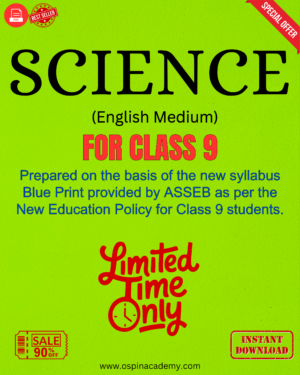SEBA Class 9 Science Chapter 8 – Motion Solutions & Summary
Looking for SEBA Class 9 Science Chapter 8 – “Motion” solutions? At Ospin Academy, you will find NCERT-based textbook answers, multiple-choice questions (MCQs), and a detailed chapter summary to help you excel in exams.
📖 Chapter Overview:
This chapter introduces the concept of motion, types of motion, equations of motion, and graphical representation of motion.
📌 Key Topics Covered:
- ⭐ What is Motion?
- ⭐ Types of Motion – Uniform and Non-Uniform
- ⭐ Distance vs Displacement
- ⭐ Speed, Velocity, and Acceleration
- ⭐ Equations of Motion
- ⭐ Graphical Representation of Motion
📌 Important Concepts:
- ⭐ How is motion classified?
- ⭐ What is the difference between speed and velocity?
- ⭐ What are the three equations of motion?
- ⭐ How are motion graphs used to analyze movement?
- ⭐ What is acceleration, and how is it calculated?
📝 How Ospin Academy Helps:
- ✅ Exam-Oriented Solutions: Fully NCERT-based Class 9 Science solutions.
- ✅ MCQs and Extra Questions: Important multiple-choice questions for better revision.
- ✅ Concept Clarity: Explanation with real-life examples.
- ✅ Quick Revision Notes: Key points summarized for last-minute preparation.
Access complete SEBA Class 9 Science Chapter 8 – “Motion” solutions at Ospin Academy and improve your understanding today!
Class 9 Science (English Medium) PDF Solutions 2025-26 | SEBA Assam
Download Class 9 Science (English Medium) PDF with detailed solutions, MCQs, and additional practice questions for SEBA Assam 2025-26.
Class 9 Science
Chapter – 8 Ospin Academy
Motion
![]()
TEXTUAL QUESTIONS ANANSWERS
Page – 100
1. An object has moved through a distance. Can it have zero displacement? If yes, support your answer with an example.
Answer: Yes, an object can have zero displacement even though it has covered a distance. For instance, if an object moves from point A to point B, which is 20 m away, and then returns back to point A directly, the displacement will be zero since the starting and ending positions are identical.
Therefore, the displacement is zero.
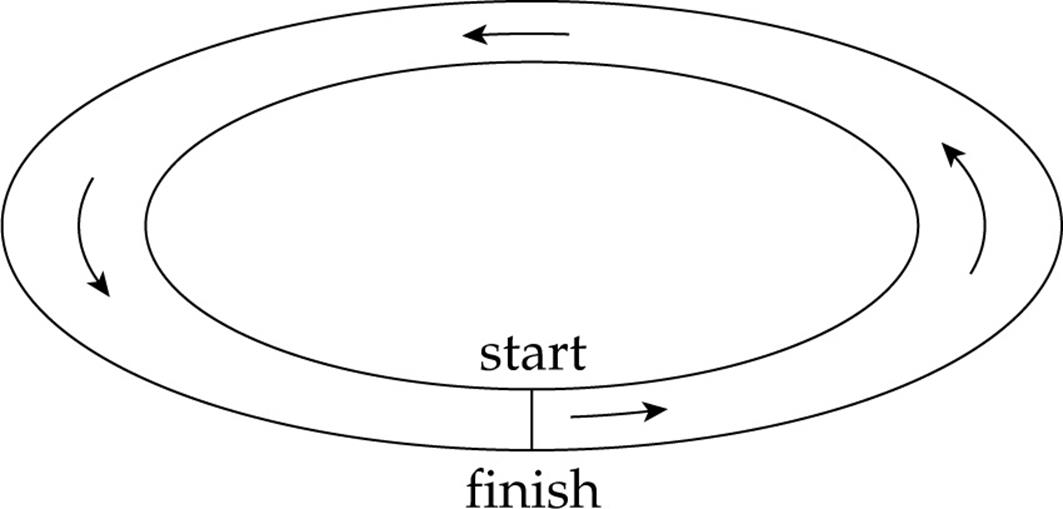
2. A farmer moves along the boundary of a square field of side 10 m in 40 s. What will be the magnitude of displacement of the farmer at the end of 2 minutes 20 seconds from his initial position?
Answer:
Let ABCD be the square field of side 10 m.
Perimeter of the field = 4 x 10 m
= 40 m
Distance covered by the farmer in 40 s = 40 m
Speed of the farmer = 40 m / 40 s
= 1 m s⁻¹
Suppose, the farmer starts moving around the field from point A.
The distance covered by the farmer in 2 minutes 20 seconds, that is, in 140 s is
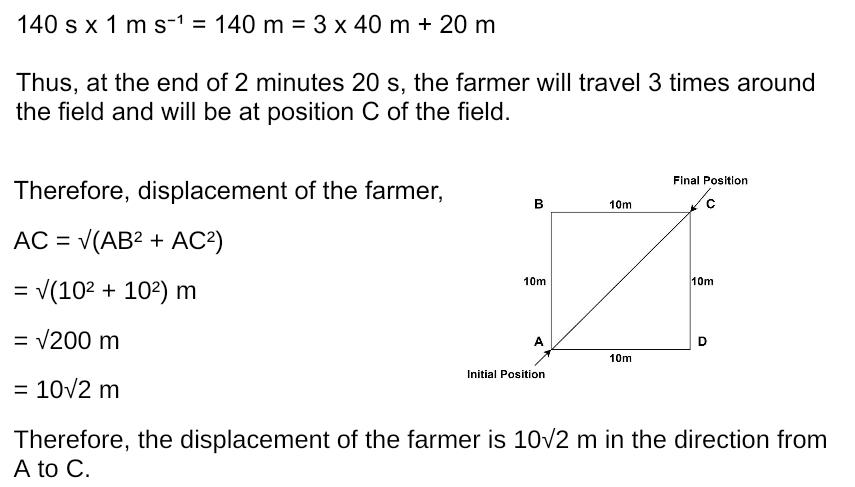
3. Which of the following is true for displacement?
(a) It cannot be zero.
Answer: False, because displacement can be zero.
(b) Its magnitude is greater than the distance travelled by the object.
Answer: False, because its magnitude is either less or equal to the distance travelled by the object.
Page – 102
1. Distinguish between speed and velocity.
Answer: Speed is a scalar quantity, which only provides information about how fast an object is moving, without considering direction. Velocity, however, is a vector quantity, as it not only gives the magnitude of the object’s speed but also the direction of its displacement relative to a reference point.
2. Under what condition (s) is the magnitude of average velocity of an object equal to its average speed?
Answer: The magnitude of average velocity of an object is equal to its average speed when the displacement of the object is equal to the distance covered by it in a given time interval.
3. What does the odometer of an automobile measure?
Answer: The odometer measures the distance travelled by the automobile.
4. What does the path of an object look like when it is in uniform motion?
Answer: The path of an object looks like a straight line when it is in uniform motion.
5. During an experiment, a signal from a spaceship reached the ground station in five minutes. What was the distance of the spaceship from the ground station? The signal travels at the speed of light, that is, 3 × 10⁸ m s⁻¹.
Answer: Speed of the signal, v = 3 × 10⁸ m s⁻¹ Time taken, t = 5 minutes = 300 s Distance, s = ?
We know
S=v×t
= 3 × 10⁸ m s⁻¹ × 300 s
= 9 × 10¹⁰ m
Therefore, the distance of the spaceship from the ground is 9 × 10¹⁰ m.
Page -103
1. When will you say a body is in
-
- Uniform acceleration?
Answer: A body moving in a straight line is said to have uniform acceleration body changes uniformly with time.
(ii) Non-uniform acceleration?
Answer: A moving body is said to have non-uniform acceleration if the velocity of the body change in the velocity body in equal intervals of time is different.
2. A bus decreases its speed from 80 km h-¹ to 60 km h-¹ in 5s. Find the acceleration of the bus.
Answer
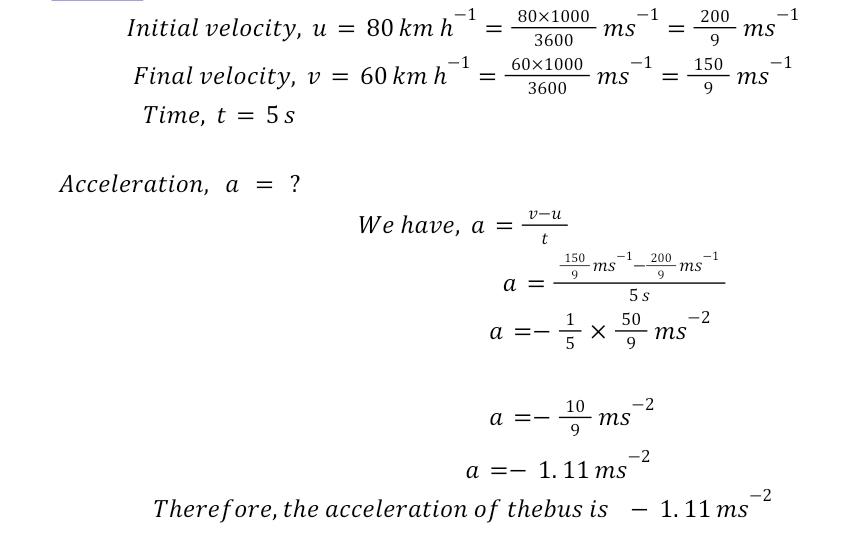
3. A train starting from a railway station and moving with uniform acceleration attains a speed 40 km h-¹ in 10 minutes. Find its acceleration.
Answer: Initial velocity, u = 0 m s⁻¹
Final velocity, v = 40 km h⁻¹ = 40 × 1000 / 3600 m s⁻¹ = 100/9 m s⁻¹
Time, t = 10 minutes = 600 s
Acceleration, a = ?
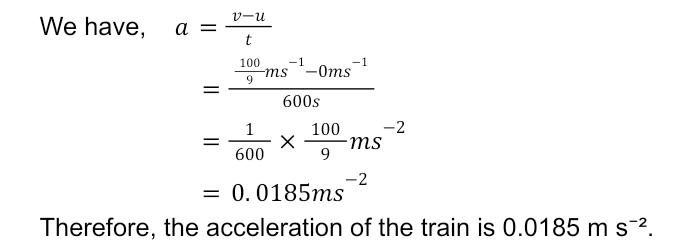
Textbook Page No. 107
1. What is the nature of the distance-time graphs for uniform and non-uniform motion of an object?
Answer: The distance-time graph of an object for uniform motion is a straight line and for non-uniform motion is a curved line.
2. What can you say about the motion of an object whose distance-time graph is a straight line parallel to the time axis?
Answer: If the distance-time graph of an object is a straight line parallel to the time axis, it means that the object is at rest since its position does not change with time.
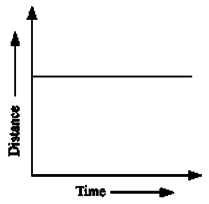
3. What can you say about the motion of an object if its speed-time graph is a straight line parallel to the time axis?
Answer: If the speed-time graph of an object is a straight line parallel to the time axis, it means that the object is moving with a uniform speed.
4. What is the quantity which is measured by the area occupied below the velocity-time graph?
Answer: Distance travelled by the body in the given interval of time is measured by the area occupied below the velocity-time graph.
Page – 109-110
1. A bus starting from rest moves with a uniform acceleration of 0.1 ms-2 for 2 minutes. Find
(a) The speed acquired
(b) The distance travelled.
Answer:
Initial velocity, u = 0 m s⁻¹ Acceleration, a = 0.1 m s⁻² Time, t = 2 minutes = 120 s Final velocity, v = ?
Distance travelled, s = ?
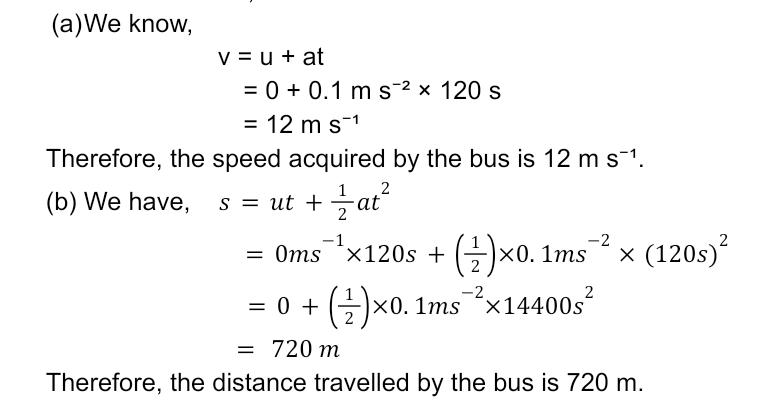
2. A train is travelling at a speed of 90 km h⁻¹. Brakes are applied so as to produce a uniform acceleration of – 0.5 m s⁻². Find how far the train will go before it is brought to rest.
Answer:

Therefore, the distance travelled by the train is 625 m.
3. A trolley, while going down an inclined plane, has an acceleration of 2 cm s-2. What will be its velocity 3 s after the start?
Answer: 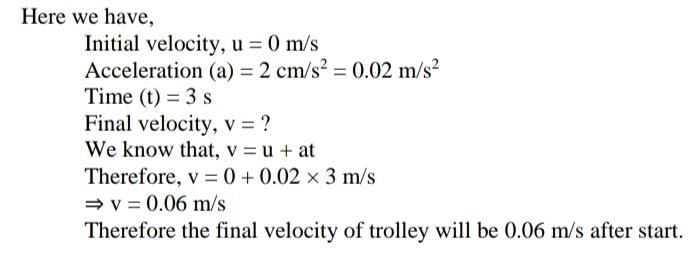
4. A racing car has a uniform acceleration of 4 m s⁻². What distance will it cover in 10 s after start?
Answer:
Acceleration, a = 4 m s⁻² Initial velocity, u = 0 m s⁻¹ Time, t = 10 s
Distance covered, s=? We have, 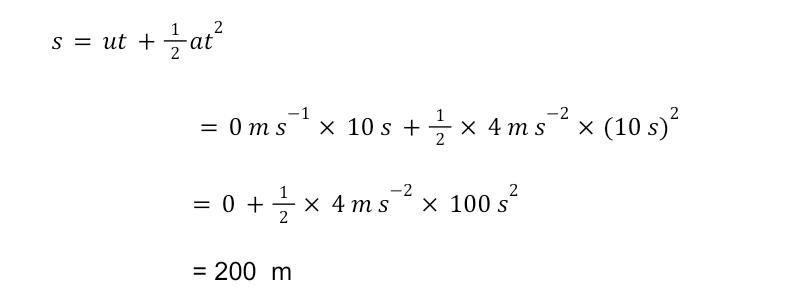
Therefore, the distance covered by the racing car is 200 m
5. A stone is thrown in a vertically upward direction with a velocity of 5 ms⁻¹. If the acceleration of the stone during its motion is 10 ms⁻² in the downward direction, what will be the height attained by the stone and how much time will it take to reach there?
Answer: Initial velocity, u = 5 m s⁻¹
Acceleration, a = – 10 m s⁻² [As the acceleration is in the direction opposite to that of the velocity]
At the highest point,
Final velocity, v= = 0 m s⁻¹ Height attained, s = ?
Time taken, t = ?
We have,
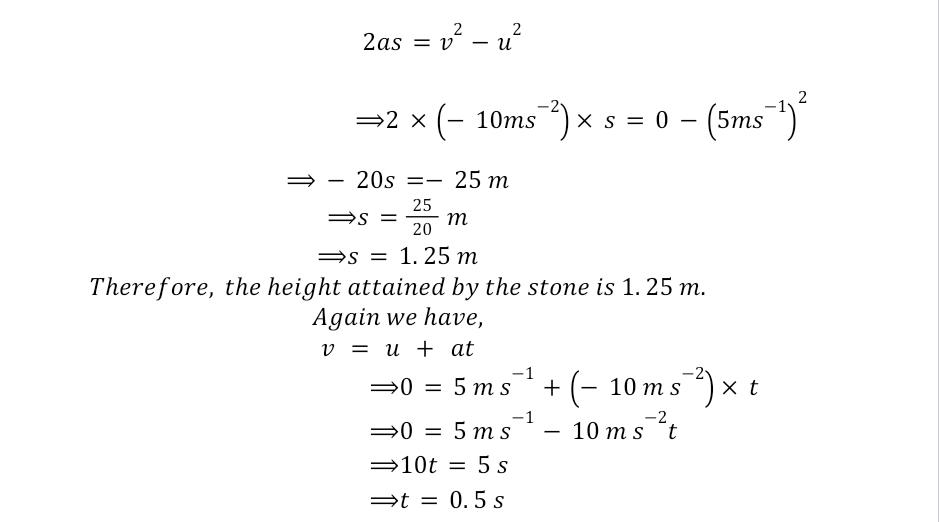
Therefore, the time taken by the stone to reach the highest point is 0.5 s.
EXERCISE
Textbook Page No. 112-113
1. An athlete completes one round of a circular track of diameter 200 m in 40 s. What will be the distance covered and the displacement at the end of 2 minutes 20 s?
Answer: 
2. Joseph jogs from one end A to the other end B of a straight 300 m road in 2 minutes 30 seconds and then turns around and jogs 100 m back to point C in another 1 minute. What are Joseph’s average speeds and velocities in jogging
-
- from A to B.
- from A to C?
Answer: 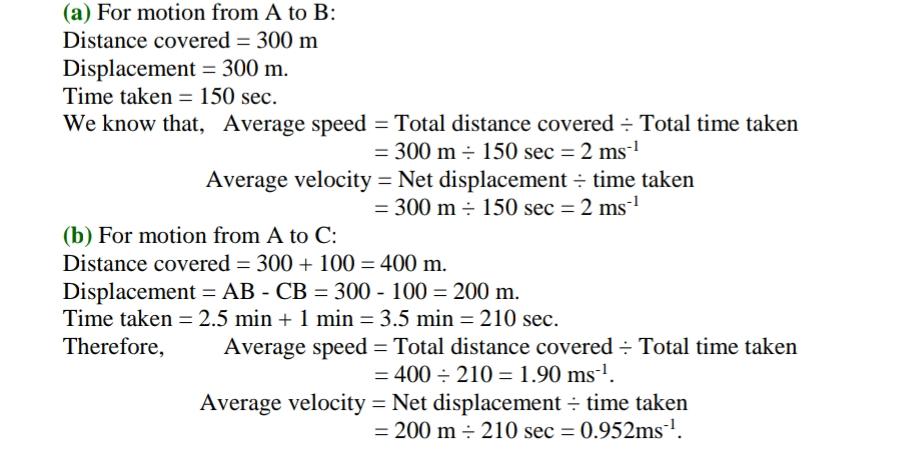
3. Abdul, while driving to school, computes the average speed for his trip to be 20 km h⁻¹. On his return trip along the same route, there is less traffic and the average speed is 30 km h⁻¹. What is the average speed for Abdul’s trip?
Answer:
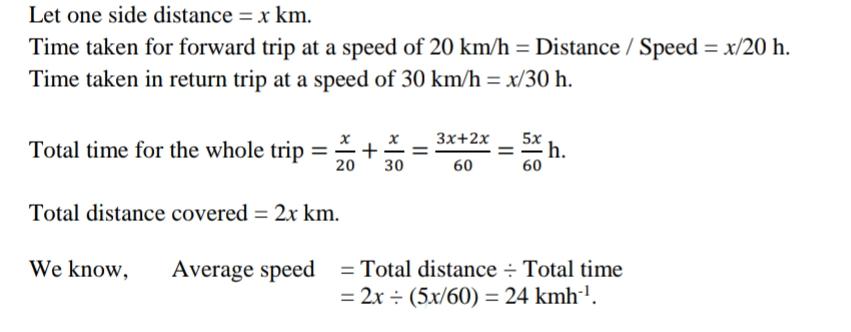
4. A motorboat starting from rest on a lake accelerates in a straight line at a constant rate of 3.0 ms⁻² for 8.0 s. How far does the boat travel during this time?
Answer: Here, initial velocity, u = 0 Acceleration, a = 3.0 m s⁻² Time, t = 8.0 s
Distance, s = ? We know,

5. A driver of a car travelling at 52 km h⁻¹ applies the brakes and accelerates uniformly in the opposite direction. The car stops in 5 s. Another driver going at 3 km h⁻¹ in another car applies his brakes slowly and stops in 10 s. On the same graph paper, plot the speed versus time graphs for the two cars. Which of the two cars travelled farther after the brakes were applied?
Answer:

Time taken by the first car to stop, t1¡ = 5s Time taken by the second car to stop, t2 = 10s
Now, AB represents the speed-time graph of the first car and CD represents the speed- time graph of the second car.

Therefore, the first car travelled farther after the breaks were applied.
6. Fig. shows the distance-time graph of three objects A, B and C. Study the graph and answer the following questions:
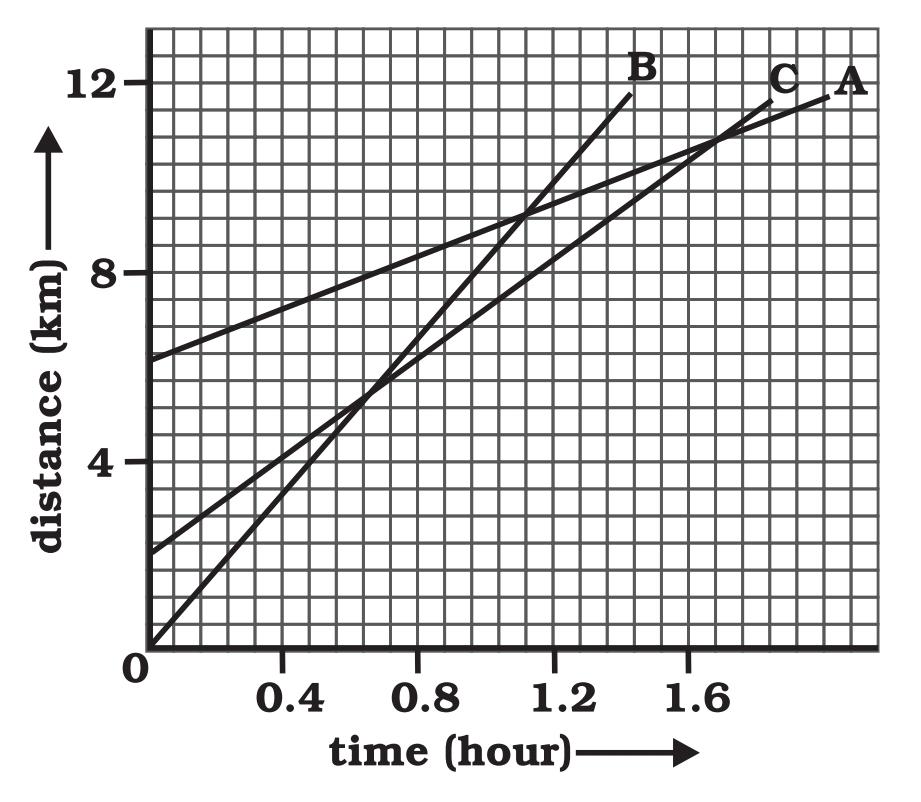
(a) Which of the three is travelling the fastest?
(b) Are all three ever at the same point on the road?
(c) How far has C travelled when B passes A?
(d) How far has B travelled by the time it passes C?
Answer:

7. A ball is gently dropped from a height of 20 m. If its velocity increases uniformly at the rate of 10 m s⁻², with what velocity will it strike the ground? After what time will it strike the ground?
Answer:
Here,
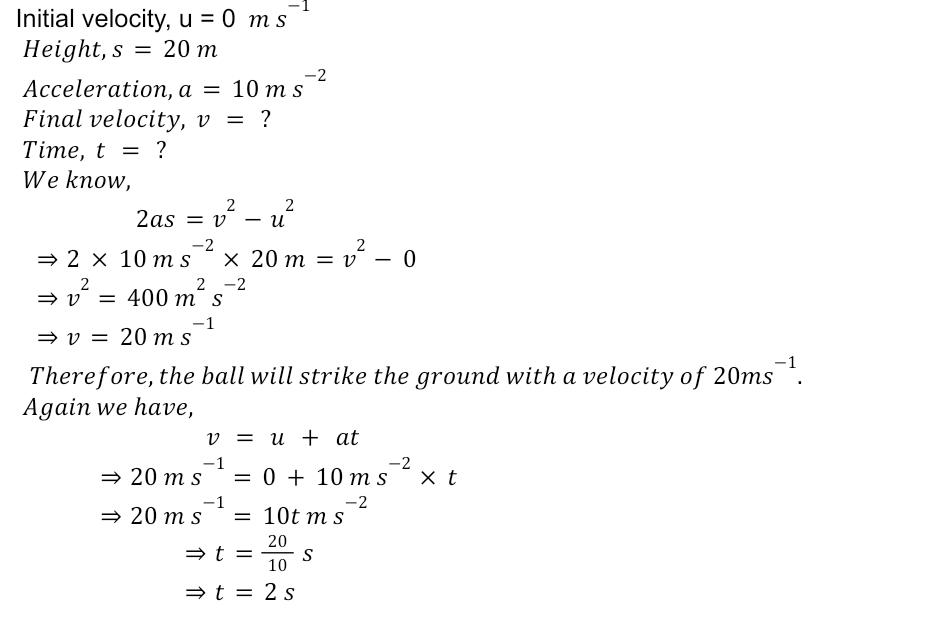
Therefore, the ball will strike the ground after 2 seconds.
8. The speed-time graph for a car is shown is Fig. 7.11.
(a) Find how far does the car travel in the first 4 seconds. Shade the area on the graph that represents the distance travelled by the car during the period.
(b) Which part of the graph represents uniform motion of the car?
Answer:
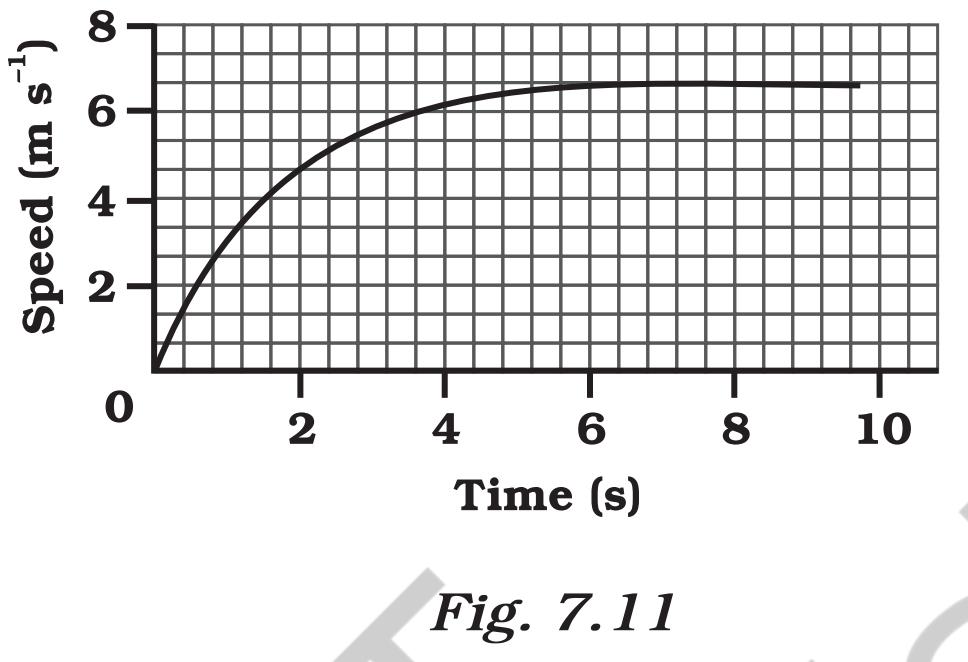
The shaded area gives the distance travelled by the car in first 4 seconds.
Now,
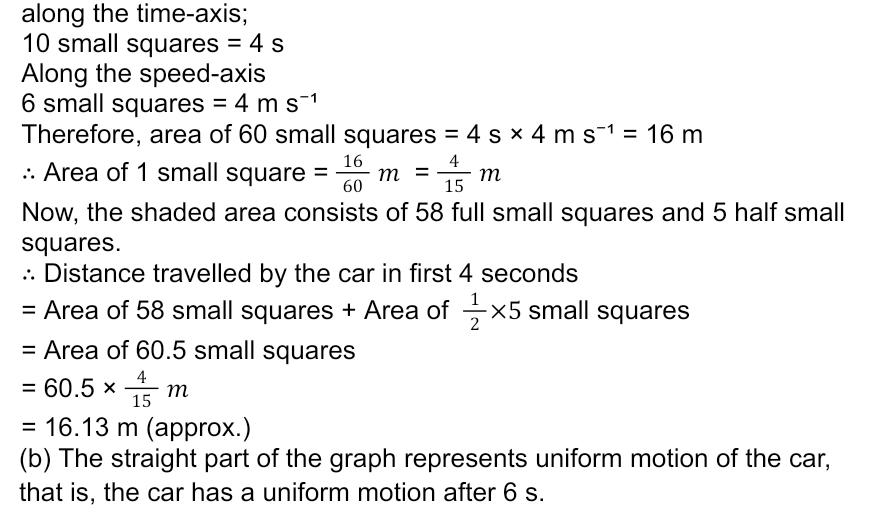
9. State which of the following situations are possible and give an example for each of these:
(a) an object with a constant acceleration but with zero velocity.
(b) an object moving in a certain direction with an acceleration in the perpendicular direction.
Answer:
(a) Yes, the given situation is possible.
For example, when a stone is thrown upwards, its velocity is zero at highest point but it has acceleration equal to acceleration due to gravity, that is, 9-8 ms.
(b) Yes, the given situation is possible.
For example, a bird flying horizontally is acted upon by acceleration due to gravity acting in the vertically downwards direction, that is, in a direction perpendicular to the direction of the flying bird.
10. An artificial satellite is moving in a circular orbit of radius 42250 km. Calculate its speed if it takes 24 hours to revolve around the earth.
Answer:
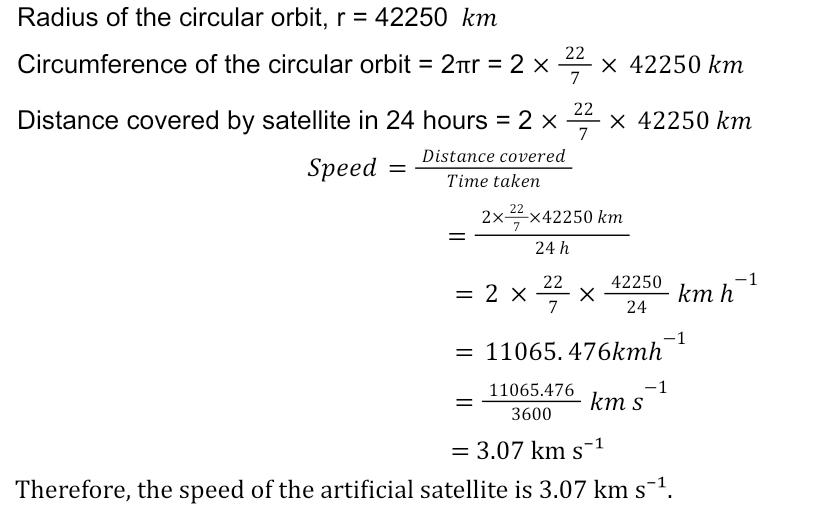
SEBA Assam Class 9 Science Chapter 8 – Motion FAQs
Get Free NCERT PDFs
If you want to download free PDFs of any chapter, click the link below and join our WhatsApp group:
